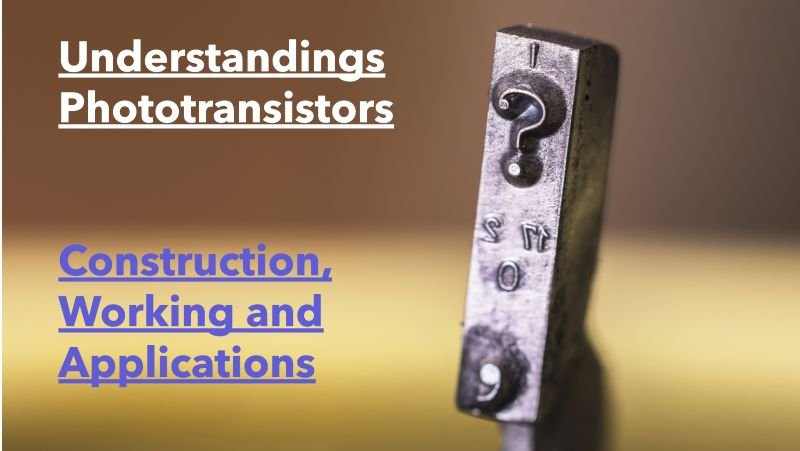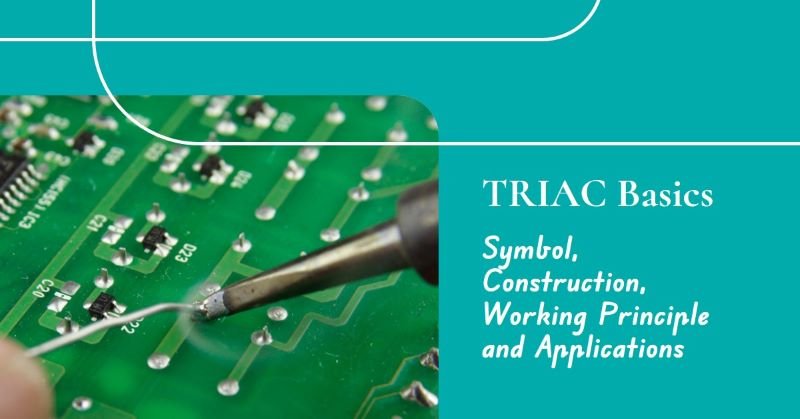Understandings Phototransistors: Construction, Working and Applications
What is a Phototransistor?
A phototransistor is a transistor with a collector-base junction highly sensitive to light. When light falls on this junction, it generates a base current proportional to the light’s intensity, allowing current to flow. Unlike standard transistors, a phototransistor’s input is light instead of electrical signals. It combines the photo-responsiveness of a photodiode with the current amplification capability of a transistor. Phototransistors have two junctions and are primarily used for light sensing and amplification.
Phototransistors operate by utilizing the photoelectric effect, where light photons generate electron-hole pairs in the collector-base junction. This mechanism makes them uniquely capable of detecting and amplifying light signals, translating them into electrical output with high efficiency.
Construction

Materials Used
Phototransistors are primarily made from semiconductor materials such as silicon or germanium. Silicon is widely preferred for its superior light sensitivity and thermal stability, while germanium is sometimes used for applications requiring lower energy thresholds. Some advanced phototransistors also utilize compound semiconductors like gallium arsenide for specialized applications.
Basic Design and Components
A phototransistor consists of three main components:
- Base Region: The light-sensitive area where photons generate charge carriers.
- Collector: The region where the amplified current is collected.
- Emitter: The region that emits the amplified current.
Phototransistors often have a transparent casing or lens to allow light to directly reach the base region, enhancing sensitivity. The collector-base junction is designed larger than the emitter-base junction to maximize light absorption. In addition to standard designs, some phototransistors have a built-in optical lens to focus light more effectively on the active junction.
Different Types of Phototransistors
-
- NPN Phototransistor: The most common type, where the collector is positively biased, and current flows from the collector to the emitter when exposed to light.
- PNP Phototransistor: The collector is negatively biased, and current flows from the emitter to the collector under light exposure.
- Darlington Phototransistor: Combines two transistors for higher current gain, making it highly sensitive to low light levels.
- Avalanche Phototransistor: Designed for extreme sensitivity, using the avalanche multiplication effect to amplify current significantly.
Comparison with Photodiodes and Standard Transistors
- Photodiodes: While photodiodes are used to detect light, they do not amplify the current like phototransistors. Phototransistors provide higher sensitivity and output.
- Standard Transistors: Standard transistors rely on electrical signals to control current, whereas phototransistors use light as the control mechanism, integrating sensing and amplification functions in a single device.
Working Principle
How Phototransistors Detect and Amplify Light
Phototransistors function by utilizing the photoelectric effect to generate a photocurrent. When photons hit the collector-base junction, they excite electrons, creating electron-hole pairs. This process leads to a base current proportional to the intensity of the incident light. As a result, a much larger current flows between the collector and emitter, amplifying the initial light-induced signal.
Role of Light in Creating Charge Carriers
Light energy reduces the resistance at the collector-base junction, allowing charge carriers to flow more freely. The intensity of the light determines the number of charge carriers generated, directly impacting the magnitude of the output current.
Key Operational Concepts
- Photoelectric Effect: The phenomenon where photons excite electrons in a material, creating charge carriers. This is the foundational principle of phototransistor operation.
- Current Amplification Due to Light Exposure: The small current generated by light is amplified by the transistor’s internal gain mechanism, resulting in a larger and more usable output current.
Applications and Uses
Common Uses in Various Industries
- Consumer Electronics:
- Remote controls to detect IR signals.
- Ambient light sensors for display brightness adjustment.
- Industrial Automation:
- Optical encoders for precise motion control.
- Object detection systems in manufacturing lines.
- Security Systems:
- IR detection in motion sensors.
- Light-based intrusion detection systems.
- Medical Devices:
- Pulse oximeters for measuring blood oxygen levels.
- Non-invasive heart rate monitors.
- Automotive Applications:
- Automatic headlight dimming systems.
- Rain sensors for windshield wipers.
Advantages Over Other Light-Sensitive Devices
- Higher sensitivity and better amplification compared to photodiodes.
- Simplicity in design, reducing the need for additional amplification circuits.
- Ability to operate in a wide range of light conditions.
Limitations and Considerations in Practical Usage
- Slower response time compared to photodiodes, making them unsuitable for high-speed applications.
- Limited spectral sensitivity, depending on the material used.
- Susceptibility to ambient light interference, requiring careful shielding or filtering in specific applications.
Conclusion
In conclusion, Phototransistors are indispensable components in modern electronics, offering an efficient way to detect and amplify light. Their versatility and sensitivity make them ideal for various applications, from consumer devices to industrial automation and medical technologies. While they have some limitations, advancements in material science and design are continually enhancing their performance and expanding their use cases. As technology progresses, phototransistors are expected to remain vital in developing innovative light-based solutions.
FAQs
1. What is the primary advantage of a phototransistor over a photodiode?
Phototransistors combine light detection and current amplification in one device, providing higher sensitivity and eliminating the need for additional amplification circuitry.
2. Can a phototransistor detect infrared light?
Yes, many phototransistors are designed to detect infrared light, making them suitable for applications like remote controls and IR motion sensors.
3. What are the limitations of phototransistors?
Phototransistors have slower response times compared to photodiodes and can be affected by ambient light interference, requiring shielding in certain applications.
4. How do Darlington phototransistors differ from standard phototransistors?
Darlington phototransistors combine two transistors to achieve a higher current gain, making them more sensitive to low light levels.
5. Are phototransistors suitable for high-speed applications?
No, due to their slower response times, phototransistors are less suitable for high-speed applications like optical communication.








